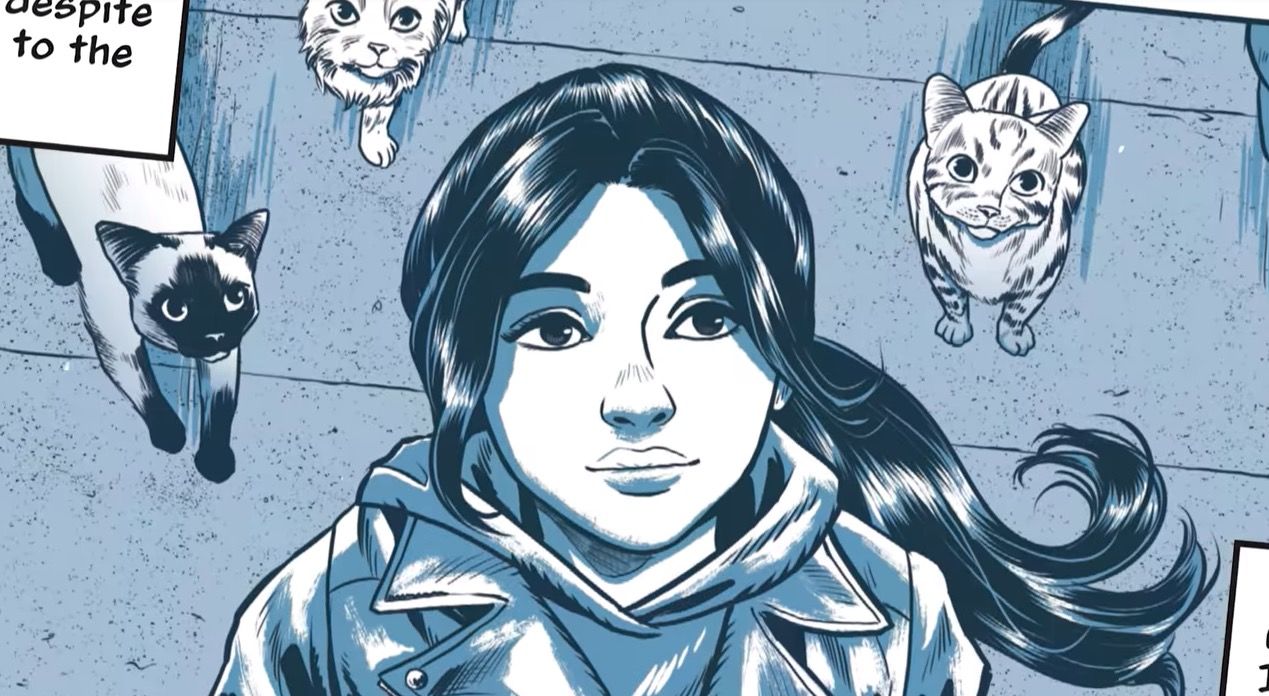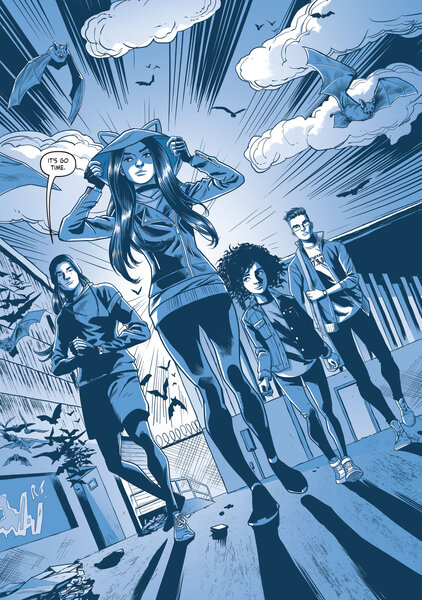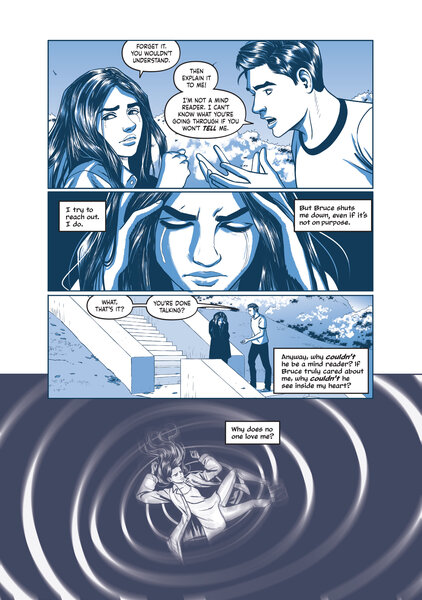Create a free profile to get unlimited access to exclusive videos, sweepstakes, and more!
Lauren Myracle on her Selina Kyle reimagining in Under the Moon: A Catwoman Tale

Under the Moon: A Catwoman Tale, written by Lauren Myracle and illustrated by Isaac Goodhart, is the second title to be released under DC Ink, and it has a very different tone than the more recent release Mera: Tidebreaker — dealing with important issues like cutting, domestic violence, homelessness, animal abuse, and suicide. Releasing in comic book shops on May 1 and everywhere comics are sold on May 7, tackling such issues makes it an ideal read for Mental Health Awareness Month.
Myracle is often considered one of the country’s most “challenged” authors, as several of her past works have topped the nation’s “most banned” book lists. She now brings her signature authentic teen storytelling to DC to tell a powerful story through the lens of a teenage Selina Kyle (a.k.a. Catwoman). SYFY WIRE Fangrrls had the opportunity to chat with the author about her YA graphic novel debut and her reimagining of Selina into a fierce, troubled teenager trying to survive the hand that was dealt to her.
You have a lot of experience writing for children and young adults, and this comic deals with some heavy subject matter. Can you speak to how you handle representing some of these darker issues, like abuse or homelessness, for young audiences?All of my books, unless they're for like six-year-olds, deal with topics that for whatever reasons, other adults [focus on]—it's never the kids that say, oh, this has tough issues or dark issues.
The dark issues in Catwoman are not something that's new for me. I guess I've always had a creed of why in the world would we hide stuff from kids, when kids go to books for affirmation, for reassurance, [to know] they are not alone and not different and not weird. So in terms of how straightforward I can be about that stuff, I'm definitely aware that if I'm writing for middle grade—which in my mind is like 12 and under— I'm going to be careful. These kids are—I've got kids of my own—more innocent when they are that age and they don't want to necessarily lose that innocence, there's no reason to lose it before you have to.
But after 12, sometimes the people that I see that are the gatekeepers, meaning the parents and librarians, would love to think that kids are naïve and that kids are still protected from these issues. But no real blood and flesh child that I've ever met at age 13 has been nearly as innocent as the grown-ups think they are.
I'm writing the books for the kids, not for the librarians, not for the bookshop owners, and I'm going to respect the kids by not talking down to them and hiding the fact that the world can be really hard sometimes.
I go to conferences and they say, oh my goodness, you're showing a mean stepdad, or a mean boyfriend, like Dernell in Catwoman. And I'm like, yeah. These kids are watching Breaking Bad and listening to misogynistic [music]... I do think [the gatekeepers] sometimes forget that kids are actually a population group in the entire big world, not just in their classrooms, in their bookstores, and in their beds.
The interview between you and [artist] Isaac Goodhart in the back of the book is great. I know you guys hadn't actually met in person. What was the relationship like while you were working?
I love Isaac so fully … it just makes my heart melt. Still never met him. He gave me street-cred in a way because he has been a DC Comics die-hard fan — nerd if you would say — since he was little. And so, working for DC, drawing for DC, has been his dream. If you get to be a part of that with him, it brought back that joy and exhilaration.
I'm 20 years further into my career than he is, so it's really beautiful to have his infusion of enthusiasm. He was just so tickled about adding Easter eggs and adding expressions. I've never written anything else [like comics] before or even written an illustrated book.
The layers upon layers of depth that he had or [the fact that] he has lived for the work blew my mind. You have to think about it: what collaboration is, if everyone's in it for real, you want to do better. I've certainly started writing for Isaac and maybe Isaac [started] drawing for me, and we're also doing it for our readers... but when good people come together, it ups each person's game.
Tell us a little bit about working on comics versus novels.
It's crazy different. After thinking about it again—because right now I'm drafting a new graphic novel, and I'm also drafting a novel—I'm kind of switching back and forth between the two, and I think that the vigor of writing a graphic novel, it makes for a better story … The thing with DC, they make me turn in an outline and they make me turn in a script in chunks. I'm not an outline writer in my normal writing life.
So, to write an outline means I've got to visualize it ahead of time, and when you're writing in script, each panel has to have action, has to have movement. In a novel, I feel like I can sometimes just open up my computer, see the blank screen, and start writing.
Writing has its own dimension and the words pull you along. But, you can look at the scene afterward, saying, "Wow, nothing happened in that scene whatsoever." When you're writing a scripted graphic novel, you can see right away that you're writing in panel descriptions. They have to do something. I think a lot of us writers like to sit and watch the world anyway. So, in a novel, it's easy to write about characters who sit and watch the world, but nobody wants to read about characters who sit and watch the world. When you're writing a graphic novel, you really have to get them up and moving.
One of the things that's so great about comics is that you have different versions of the same character. In the backmatter of the book, you mention that you were obviously aware of Catwoman from the movies and things like that, but how did you find your version of Selina?
Yeah, absolutely. So, my opinion is of Selina—she was independent, probably aggressively independent, which suggested to me that she's been hurt. I mean, if somebody refuses to take help from others, then that means they've been hurt sometime in the past and had trust issues. I thought of her as being a creature of the night and that she's capable, light on her feet, agile. So, what would it take to make a young girl, 15-years-old leave her house and take to a life on the street? In a comic book role, you kind of accept that leap, but if you're thinking about it as a real-life person—it's tragic and scary if you're 15, to leave your house and try to fend for yourself.
That's why her back story is dark. A girl who is riding ponies and eating marshmallows and having great slumber parties—there's no reason she would leave that world behind. On the other hand, a mean boyfriend who plays mental games with you, that's scary. She has this huge core of self-reliance, so she's strong and brave, and says, "OK, enough of that" and she leaves to set out on her own. But, then when she finds Rosie, she realizes, "oh, I do have the chance to do what people did not do for me and take this kid under my wing and give this kid some kind of strength the way I wish a bigger person had done for me."
There's such a great message here about finding family wherever you can— whether you stay with them or don't stay with them—and that there are moments and people in your life that can change everything for you. Was that a really important message to put in there?
I think that's just such a human message ... Oh golly, when I was little, I had the idea that any true friendship would last forever. Now that I'm older, I realize that's not necessarily true because people change. We're always dynamic. We're always changing. But, that doesn't mean that the friendship that existed wasn't absolutely as important and as strong as it was at the moment.
If you think back on your best friend when you were in seventh grade, maybe you're not best friends with her anymore, but that those moments then mattered and really molded you and helped you up. You were saying about Selina, that you get the sense that she walks away from Rosie and that Rosie walks away from Selina. But, that does not mean that the bond they formed wasn't real … We find family where we can, and that family stays a part of us even if we grew [from] a bond into another phase of our life.
At the end of the book, you've provided resources for people dealing with mental health issues and abuse and trauma. Was that your decisions? Was that something DC wanted to do?
That was something that DC and I talked about together and we both said yep, absolutely. If we're going to tell a story like this, we also need to acknowledge that this is not just [fiction], but it is real, and we'd do anything we can to give our readers access to somebody that can talk to them and not turn them down.
Do you have a favorite moment from this story?
Two come to mind. One: Selina is kind of teenage drooling over Bruce [Wayne] in the math classroom. She's talking about how beautiful he is, and she says that his hair... I think she compares it to the wings of a crow. I think it's said so beautifully, and then his hair, it's combed, it's shiny black… So, I love that just because it's such a visual moment and it so captures the intensity of infatuation for a 15-year-old girl. That's one favorite moment.
Then my other favorite moment, I think of it visually. I think of Isaac's drawing, when Selina says, "It's go time." And, the kids all march off, so it's a gang shot. It's this flash where Selina is flipping her hoodie with the cat ears over her head, and Ojo and Yang and Rosie are all walking behind [her] and they look... their chins are up, and their eyes are fierce, and they're a little bit nervous, and they're off to go do this heist. I love that.
One of the things I think that people love so much about Selina Kyle is that she's both the good guy and the bad guy. To that end, I'd love to hear your thoughts on balancing that especially at the beginning of her story.
I get to be contrary on this one. If Selina Kyle was one of my minor characters, maybe I would see her as both good and both bad. Because I'm writing Selina, because I'm an optimist, because Selina is not a sociopath without a moral conflict, I don't see Selina as bad. I see her as awesome, and brave, and broken. Maybe broken is my equivalent to bad, but I don't see her doing anything representative in a way that hurts [another person]. I guess my definition of bad is hurting other people on purpose either for your own gain, or for your own pleasure, like your own spite, and she doesn't do that. The Growler, he's bad. He kills people. He's a monster. Dernell is bad. He uses his power to hurt people who are weaker. Selina responds to things that are bad. She isn't perfect, but I see her as having a good, good heart, and I see her trying to protect that heart. She's no longer a sunshine child. She's not a child that sees everything that's beautiful and bright and so, she's come up with coping mechanisms. She's a realist.
You can follow Lauren Myracle on Twitter here. An excerpt from Under the Moon: A Catwoman Tale is DC’s gold title for Free Comic Book Day tomorrow, May 4. Myracle is also kicking off her four-city book tour at Yallwest on May 4.




























